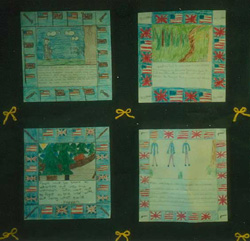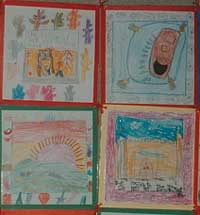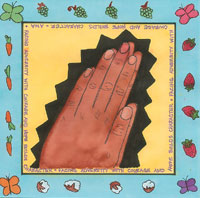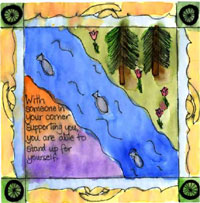| Literature Circles Resource Center | |
| home | site map | structure | books | discussion | written response | themed units | extension projects | |
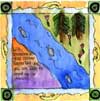 |
|
|
Story
Quilt for more on Story Quilts, see Chapter 8 Getting Started with Literature Circles Katherine L. Schlick Noe and Nancy J. Johnson ©1999 Christopher-Gordon Publishers, Inc. |
| A story quilt is an ideal whole-class extension project that works at all grade levels. Quilt squares feature chapters, characters, or significant scenes from the literature circle book. They can include a border with a repeated design or symbol that represents a key idea. Quilt squares can incorporate visual as well as written components (e.g., an important quote or brief summary). Effective adaptations are possible for all grade levels.
Directions 2. Squares can be made from paper or cloth. The simplest format is white construction or copy paper cut into a square with dimensions of nine to 12 inches. The size of the square and the number of students will determine how large your final quilt will be. 3. We suggest that you guide students to draw a draft of their quilt square on scratch paper. This will help them plan the spacing and arrangement of their visual and written responses. 4. Around the edges of the square, students draw a one-inch border. 5. Inside the border the students create their illustration. We suggest that you have them include a sentence or two explaining the significance of the illustration, or a quote directly from the book that supports the illustration. 6. Students can create their quilts with their literature circle group (so that each group uses a common motif for the border but each student creates his/her own square). You can also create the quilt with the whole class. In that case, students brainstorm ideas for symbols to go around the border and then vote for their favorite. 7. As a final touch, every student draws in the border. 8. You then mount all the squares on a long strip of butcher paper. If you don’t have the right number of squares to make even rows, you can have a student (or group) create an extra square with the title of the book and author. If you need yet another square to even things out, you can ask another student to create a square that identifies the class that made the quilt and include the date. REMEMBER: An
important part of extension projects is having each student present
their project to the class. With the quilt it is fun to sit in a
circle and have each student lay their square on the floor as they
talk about their process. This way students get to see the quilt
slowly come together into one complete work of art. Examples Several examples are shown below. The first is from a 5th grade classroom reading books set during the Revolutionary War and focused on a theme of Finding the Courage to Help Others. The quilt square pictured on the left came from the group that read My Brother Sam is Dead by Christopher and James Lincoln Collier. The group designed a border with common symbols, then each member selected an important part of the book to illustrate. Each quilt square also includes a short explanation of how the book tied to the theme. The photo on the right shows another group's segment of the assembled quilt (squares are glued onto a large piece of black butcher paper; yarn "ties" are glued in place)
|
|||||||||||||||||||||
home
| site map | structure
| books | discussion
| written response
| themed
units | extension projects
|
Literature
Circles Resource Center © 2002 Katherine L. Schlick Noe School of Education Seattle University 900 Broadway Seattle, WA 98122 kschlnoe@seattleu.edu |

